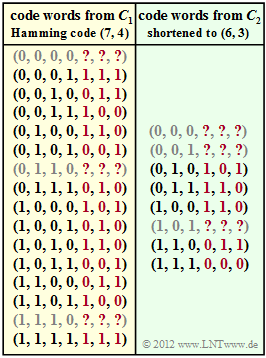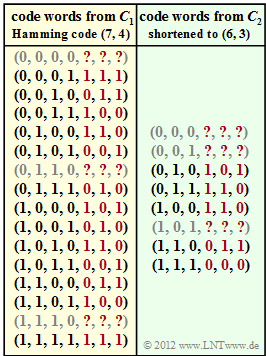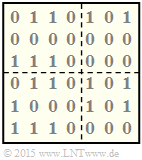Difference between revisions of "Aufgaben:Exercise 4.6: Product Code Generation"
| (2 intermediate revisions by the same user not shown) | |||
| Line 1: | Line 1: | ||
{{quiz-Header|Buchseite=Channel_Coding/The_Basics_of_Product_Codes}} | {{quiz-Header|Buchseite=Channel_Coding/The_Basics_of_Product_Codes}} | ||
| − | [[File: | + | [[File:EN_KC_A_4_6.png|right|frame|Used component codes]] |
| − | A $\rm product\:code \ (42, \ 12)$ shall be generated, based on the following component codes: | + | A $\rm product\:code \ (42, \ 12)$ shall be generated, based on the following component codes: |
* the Hamming code $\rm HC \ (7, \ 4, \ 3)$ ⇒ $\mathcal{C}_1$, | * the Hamming code $\rm HC \ (7, \ 4, \ 3)$ ⇒ $\mathcal{C}_1$, | ||
| + | |||
* the truncated Hamming code $\rm HC \ (6, \ 3, \ 3)$ ⇒ $\mathcal{C}_2$. | * the truncated Hamming code $\rm HC \ (6, \ 3, \ 3)$ ⇒ $\mathcal{C}_2$. | ||
| − | |||
| − | The code word belonging to an information block $\underline{u}$ generally results according to the equation $\underline{x} = \underline{u} \cdot \mathbf{G}$ | + | Corresponding code tables are given on the right, with three rows incomplete in each case. These are to be completed by you. |
| + | |||
| + | The code word belonging to an information block $\underline{u}$ generally results according to the equation | ||
| + | :$$\underline{x} = \underline{u} \cdot \mathbf{G}.$$ | ||
| + | As in [[Aufgaben:Aufgabe_4.6Z:_Grundlagen_der_Produktcodes|$\text{Exercise 4.6Z}$]], the following generator matrices are assumed here: | ||
:$${ \boldsymbol{\rm G}}_1 | :$${ \boldsymbol{\rm G}}_1 | ||
= \begin{pmatrix} | = \begin{pmatrix} | ||
| Line 23: | Line 27: | ||
\end{pmatrix} \hspace{0.05cm}.$$ | \end{pmatrix} \hspace{0.05cm}.$$ | ||
| − | Throughout the exercise, apply to the information block: | + | Throughout the exercise, apply to the information block: |
:$${ \boldsymbol{\rm U}} | :$${ \boldsymbol{\rm U}} | ||
= \begin{pmatrix} | = \begin{pmatrix} | ||
| Line 32: | Line 36: | ||
Searched for according to the nomenclature in section [[Channel_Coding/The_Basics_of_Product_Codes#Basic_structure_of_a_product_code|"Basic structure of a product code"]]: | Searched for according to the nomenclature in section [[Channel_Coding/The_Basics_of_Product_Codes#Basic_structure_of_a_product_code|"Basic structure of a product code"]]: | ||
| − | * the parity-check matrix $\mathbf{P}^{(1)}$ with respect to the horizontal code $\mathcal{C}_1$, | + | * the parity-check matrix $\mathbf{P}^{(1)}$ with respect to the horizontal code $\mathcal{C}_1$, |
| + | |||
* the parity-check matrix $\mathbf{P}^{(2)}$ with respect to the vertical code $\mathcal{C}_2$, | * the parity-check matrix $\mathbf{P}^{(2)}$ with respect to the vertical code $\mathcal{C}_2$, | ||
| + | |||
* the checks–on–checks matrix $\mathbf{P}^{(12)}$. | * the checks–on–checks matrix $\mathbf{P}^{(12)}$. | ||
| Line 40: | Line 46: | ||
| + | <u>Hints:</u> | ||
| + | *This exercise belongs to the chapter [[Channel_Coding/The_Basics_of_Product_Codes|"Basics of Product Code"]]. | ||
| + | *Reference is also made to the section [[Channel_Coding/The_Basics_of_Product_Codes#Basic_structure_of_a_product_code|"Basic structure of a product code"]]. | ||
| − | + | *The two component codes are also covered in the [[Aufgaben:Aufgabe_4.6Z:_Grundlagen_der_Produktcodes|$\text{Exercise 4.6Z}$]] . | |
| − | |||
| − | |||
| − | |||
| − | *The two component codes are also covered in the [[Aufgaben:Aufgabe_4.6Z:_Grundlagen_der_Produktcodes| | ||
| Line 62: | Line 67: | ||
{What are the results of column coding with the $(6, \ 3, \ 3)$ code $\mathcal{C}_2$? | {What are the results of column coding with the $(6, \ 3, \ 3)$ code $\mathcal{C}_2$? | ||
|type="[]"} | |type="[]"} | ||
| − | + 1. | + | + 1. column: $\underline{u} = (0, \, 0, \, 1) \ \Rightarrow \ \underline{x} = (0, \, 0, \, 1, \, 0, \, 1, \, 1)$. |
| − | + 2. | + | + 2. column: $\underline{u} = (1, \, 0, \, 1) \ \Rightarrow \ \underline{x} = (1, \, 0, \, 1, \, 1, \, 0, \, 1)$. |
| − | - 3. | + | - 3. column: $\underline{u} = (1, \, 0, \, 1) \ \Rightarrow \ \underline{x} = (1, \, 1, \, 0, \, 0, \, 1, \, 1)$. |
| − | + 4. | + | + 4. column: $\underline{u} = (0, \, 0, \, 0) \ \Rightarrow \ \underline{x} = (0, \, 0, \, 0, \, 0, \,0, \, 0)$. |
{What statements apply to the checks–on–checks matrix? | {What statements apply to the checks–on–checks matrix? | ||
|type="[]"} | |type="[]"} | ||
| − | + The first row is $(1, \, 0, \, 1)$ and the first column $(1, \, 1, \, 0)$. | + | + The first row is $(1, \, 0, \, 1)$ and the first column is $(1, \, 1, \, 0)$. |
| − | + The second row is $(1, \, 0, \, 1)$ and the second column $(0, \, 0, \, 0)$. | + | + The second row is $(1, \, 0, \, 1)$ and the second column is $(0, \, 0, \, 0)$. |
| − | - The third row is $(0, \, 0, \, 0)$ and the third column $(0, \, 0, \, 0)$. | + | - The third row is $(0, \, 0, \, 0)$ and the third column is $(0, \, 0, \, 0)$. |
</quiz> | </quiz> | ||
===Solution=== | ===Solution=== | ||
{{ML-Kopf}} | {{ML-Kopf}} | ||
| − | '''(1)''' Correct are the <u>proposed solutions 1 and 3</u>: | + | '''(1)''' Correct are the <u>proposed solutions 1 and 3</u>: In general: |
| − | + | :$$\underline{x} = \underline{u} \cdot \mathbf{G}.$$ | |
| − | In general $\underline{x} = \underline{u} \cdot \mathbf{G}$ | + | From this follows for |
| − | * the first row vector: | + | :* the first row vector: |
:$$\begin{pmatrix} | :$$\begin{pmatrix} | ||
0 &1 &1 &0 | 0 &1 &1 &0 | ||
| Line 93: | Line 98: | ||
\end{pmatrix} \hspace{0.05cm},$$ | \end{pmatrix} \hspace{0.05cm},$$ | ||
| − | * the second row vector: | + | :* the second row vector: |
:$$\begin{pmatrix} | :$$\begin{pmatrix} | ||
0 &0 &0 &0 | 0 &0 &0 &0 | ||
| Line 107: | Line 112: | ||
\end{pmatrix} \hspace{0.05cm},$$ | \end{pmatrix} \hspace{0.05cm},$$ | ||
| − | * the third row vector: | + | :* the third row vector: |
:$$\begin{pmatrix} | :$$\begin{pmatrix} | ||
1 &1 &1 &0 | 1 &1 &1 &0 | ||
| Line 122: | Line 127: | ||
| − | '''(2)''' Correct are the <u>proposed solutions 1, 2 and 4</u>: | + | '''(2)''' Correct are the <u>proposed solutions 1, 2 and 4</u>: |
:$$\begin{pmatrix} | :$$\begin{pmatrix} | ||
0 &0 &1 | 0 &0 &1 | ||
| Line 147: | Line 152: | ||
To this subtask is to be noted further: | To this subtask is to be noted further: | ||
| − | + | # The given first column is correct if only because it coincides with a row $($the third$)$ of the generator matrix $\mathbf{G}_2$. | |
| − | + | # The third column of the two-dimensional code word should be identical to the second column, since the same code word $(1, \, 0, \, 1)$ is assumed. | |
| − | + | # However, the given vector $(1, \, 1, \, 0, \, 0, \, 1, \, 1)$ cannot be correct if only because $\mathcal{C}_2$ is a systematic code just like $\mathcal{C}_1$. | |
| − | + | # Also the truncated $(6, \ 3, \ 3)$ Hamming code $C_2$ is linear, so that the assignment $\underline{u} = (0, \, 0, \, 0) \ \Rightarrow \ \ \underline{x} = (0, \, 0, \, 0, \, 0)$ can be stated without calculation. | |
| + | |||
| + | [[File:EN_KC_A_4_6_c.png|right|frame|Complete code tables]] | ||
| + | '''(3)''' Given on the right are the complete code tables | ||
| − | + | * of the Hamming code $(7, \ 4, \ 3)$, and | |
| − | + | ||
| + | * of the truncated Hamming code $(6, \ 3, \ 3)$. | ||
| − | |||
| − | |||
| − | One can see from this (without it being of interest for this exercise) that the codes considered here each have Hamming distance $d_{\rm min} = 3$. | + | One can see from this $($without it being of interest for this exercise$)$ that the codes considered here each have Hamming distance $d_{\rm min} = 3$. |
[[File:P_ID3012__KC_A_4_6d_v3.png|left|frame|Wanted product code]] | [[File:P_ID3012__KC_A_4_6d_v3.png|left|frame|Wanted product code]] | ||
| − | <br><br>The left graph shows the result of the whole coding. At the bottom right you can see the checks–on–checks matrix of dimension $3 × 3$. | + | <br><br> |
| + | *The left graph shows the result of the whole coding. | ||
| + | |||
| + | *At the bottom right you can see the checks–on–checks matrix of dimension $3 × 3$. | ||
<br clear=all> | <br clear=all> | ||
| − | Concerning the subtask (3) the <u>suggested solutions 1 and 2</u> are correct: | + | Concerning the subtask '''(3)''' the <u>suggested solutions 1 and 2</u> are correct: |
*It is a coincidence that here in the checks–on–checks matrix two rows and two columns are identical. | *It is a coincidence that here in the checks–on–checks matrix two rows and two columns are identical. | ||
| − | *It doesn't matter whether rows 4 to 6 of the total matrix are obtained using the code $\mathcal{C}_1$ or columns 5 to 7 are obtained using the code $\mathcal{C}_2$. | + | |
| + | *It doesn't matter whether rows 4 to 6 of the total matrix are obtained using the code $\mathcal{C}_1$ or columns 5 to 7 are obtained using the code $\mathcal{C}_2$. | ||
{{ML-Fuß}} | {{ML-Fuß}} | ||
Latest revision as of 17:09, 6 December 2022
A $\rm product\:code \ (42, \ 12)$ shall be generated, based on the following component codes:
- the Hamming code $\rm HC \ (7, \ 4, \ 3)$ ⇒ $\mathcal{C}_1$,
- the truncated Hamming code $\rm HC \ (6, \ 3, \ 3)$ ⇒ $\mathcal{C}_2$.
Corresponding code tables are given on the right, with three rows incomplete in each case. These are to be completed by you.
The code word belonging to an information block $\underline{u}$ generally results according to the equation
- $$\underline{x} = \underline{u} \cdot \mathbf{G}.$$
As in $\text{Exercise 4.6Z}$, the following generator matrices are assumed here:
- $${ \boldsymbol{\rm G}}_1 = \begin{pmatrix} 1 &0 &0 &0 &1 &0 &1 \\ 0 &1 &0 &0 &1 &1 &0 \\ 0 &0 &1 &0 &0 &1 &1 \\ 0 &0 &0 &1 &1 &1 &1 \end{pmatrix} \hspace{0.05cm},\hspace{0.8cm} { \boldsymbol{\rm G}}_2 = \begin{pmatrix} 1 &0 &0 &1 &1 &0 \\ 0 &1 &0 &1 &0 &1 \\ 0 &0 &1 &0 &1 &1 \end{pmatrix} \hspace{0.05cm}.$$
Throughout the exercise, apply to the information block:
- $${ \boldsymbol{\rm U}} = \begin{pmatrix} 0 &1 &1 &0 \\ 0 &0 &0 &0 \\ 1 &1 &1 &0 \end{pmatrix} \hspace{0.05cm}.$$
Searched for according to the nomenclature in section "Basic structure of a product code":
- the parity-check matrix $\mathbf{P}^{(1)}$ with respect to the horizontal code $\mathcal{C}_1$,
- the parity-check matrix $\mathbf{P}^{(2)}$ with respect to the vertical code $\mathcal{C}_2$,
- the checks–on–checks matrix $\mathbf{P}^{(12)}$.
Hints:
- This exercise belongs to the chapter "Basics of Product Code".
- Reference is also made to the section "Basic structure of a product code".
- The two component codes are also covered in the $\text{Exercise 4.6Z}$ .
Questions
Solution
- $$\underline{x} = \underline{u} \cdot \mathbf{G}.$$
From this follows for
- the first row vector:
- $$\begin{pmatrix} 0 &1 &1 &0 \end{pmatrix} \cdot \begin{pmatrix} 1 &0 &0 &0 &1 &0 &1 \\ 0 &1 &0 &0 &1 &1 &0 \\ 0 &0 &1 &0 &0 &1 &1 \\ 0 &0 &0 &1 &1 &1 &1 \end{pmatrix} =\begin{pmatrix} 0 &1 &1 &0 &1 &0 &1 \end{pmatrix} \hspace{0.05cm},$$
- the second row vector:
- $$\begin{pmatrix} 0 &0 &0 &0 \end{pmatrix} \cdot \begin{pmatrix} 1 &0 &0 &0 &1 &0 &1 \\ 0 &1 &0 &0 &1 &1 &0 \\ 0 &0 &1 &0 &0 &1 &1 \\ 0 &0 &0 &1 &1 &1 &1 \end{pmatrix} =\begin{pmatrix} 0 &0 &0 &0 &0 &0 &0 \end{pmatrix} \hspace{0.05cm},$$
- the third row vector:
- $$\begin{pmatrix} 1 &1 &1 &0 \end{pmatrix} \cdot \begin{pmatrix} 1 &0 &0 &0 &1 &0 &1 \\ 0 &1 &0 &0 &1 &1 &0 \\ 0 &0 &1 &0 &0 &1 &1 \\ 0 &0 &0 &1 &1 &1 &1 \end{pmatrix} =\begin{pmatrix} 1 &1 &1 &0 &0 &0 &0 \end{pmatrix} \hspace{0.05cm}.$$
(2) Correct are the proposed solutions 1, 2 and 4:
- $$\begin{pmatrix} 0 &0 &1 \end{pmatrix} \cdot \begin{pmatrix} 1 &0 &0 &1 &1 &0 \\ 0 &1 &0 &1 &0 &1 \\ 0 &0 &1 &0 &1 &1 \end{pmatrix} =\begin{pmatrix} 0 &0 &1 &0 &1 &1 \end{pmatrix} \hspace{0.05cm},$$
- $$\begin{pmatrix} 1 &0 &1 \end{pmatrix} \cdot \begin{pmatrix} 1 &0 &0 &1 &1 &0 \\ 0 &1 &0 &1 &0 &1 \\ 0 &0 &1 &0 &1 &1 \end{pmatrix} =\begin{pmatrix} 1 &0 &1 &1 &0 &1 \end{pmatrix} \hspace{0.05cm}.$$
To this subtask is to be noted further:
- The given first column is correct if only because it coincides with a row $($the third$)$ of the generator matrix $\mathbf{G}_2$.
- The third column of the two-dimensional code word should be identical to the second column, since the same code word $(1, \, 0, \, 1)$ is assumed.
- However, the given vector $(1, \, 1, \, 0, \, 0, \, 1, \, 1)$ cannot be correct if only because $\mathcal{C}_2$ is a systematic code just like $\mathcal{C}_1$.
- Also the truncated $(6, \ 3, \ 3)$ Hamming code $C_2$ is linear, so that the assignment $\underline{u} = (0, \, 0, \, 0) \ \Rightarrow \ \ \underline{x} = (0, \, 0, \, 0, \, 0)$ can be stated without calculation.
(3) Given on the right are the complete code tables
- of the Hamming code $(7, \ 4, \ 3)$, and
- of the truncated Hamming code $(6, \ 3, \ 3)$.
One can see from this $($without it being of interest for this exercise$)$ that the codes considered here each have Hamming distance $d_{\rm min} = 3$.
- The left graph shows the result of the whole coding.
- At the bottom right you can see the checks–on–checks matrix of dimension $3 × 3$.
Concerning the subtask (3) the suggested solutions 1 and 2 are correct:
- It is a coincidence that here in the checks–on–checks matrix two rows and two columns are identical.
- It doesn't matter whether rows 4 to 6 of the total matrix are obtained using the code $\mathcal{C}_1$ or columns 5 to 7 are obtained using the code $\mathcal{C}_2$.


